Wildlife Photographer of the Year: Gazing monkeys image wins
 Marsel van Oosten / WPY
Marsel van Oosten / WPYTwo snub-nosed monkeys are pictured resting on a stone and staring intently into the distance. What are they looking at, and what are they thinking?
It turns out they are watching a big barney between members of their troop.
This image of apparent serenity versus commotion is the overall winner of the 2018 Wildlife Photographer of the Year competition, announced at a gala dinner at London's Natural History Museum.
The picture was taken by Marsel van Oosten in China's Qinling Mountains.
The Dutchman had to follow the troop for many days to understand the animals' dynamics and predict their behaviour. His goal was to show in one shot the beautiful hair on a male snub-nosed monkey's back, and the creature's blue face.
Marsel's perseverance eventually paid off with this exquisite composition that includes a smaller female behind.
The photographer told BBC News he was "shocked and honoured" to receive the award. "I am happy that it is with this particular image because it is an endangered species and one that very few people even know exists and it is important that we realise that there are a lot of species on this planet that are under threat.
"It is not only rhinos, tigers and polar bears; and these kind of species deserve a lot more attention and all the protection they can get."
The image is not showy or shocking as WPY winners sometimes are. But there is something enthralling there that pulls you in, says Roz Kidman Cox, the chair of the competition's judges.
"As we were going through the entries, we just kept coming back to this one," she recalls. "It's almost like a stage set. I think what makes it are the colours and the lighting.
"These monkeys normally feed in the trees, but somehow Marsel's managed to catch them on the ground, and he's carefully thrown a very gentle flash on to the scene to illuminate that amazing fur."

Lounging leopard by Skye Meaker
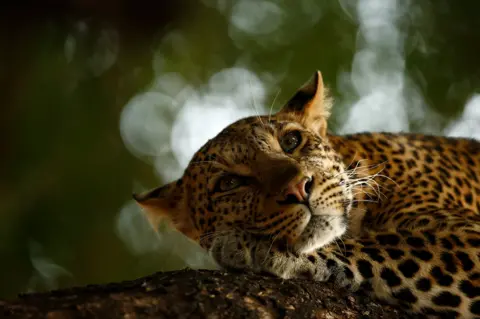 Skye Meaker / WPY
Skye Meaker / WPYThe junior winner this year is Skye Meaker from South Africa for his picture of a dozy leopard in Botswana's Mashatu Game Reserve.
The animal is well known and goes by the name of Mathoja, which in the Bantu language means "the one that walks with a limp". The leopard broke a leg as a juvenile.
It survives but has to fight hard because unlike other big cats it cannot pull dead prey into the trees to eat it, says Skye. That means eating on the ground where hyenas are always trying to pinch a kill.
"We waited several hours to get this shot. I wanted Mathoja's eyes to be open, and just for a couple of minutes that's what happened. Mathoja looked straight at us."
As well as his grand title, 16-year-old Skye wins the 15-17 Years Old category.
He has a big future, believes Kidman Cox: "I've had enough of leopards on a log; it's a cliche. But Skye has something different here. I think again it's to do with the light; the dappled green in the background. And then there's the expression on the leopard's face."
Here are some other section winners:

Pipe owls by Arshdeep Singh
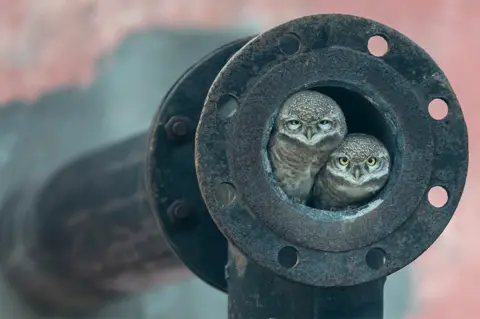 Arshdeep Singh / WPY
Arshdeep Singh / WPY10 Years And Under category - This shot is taken by another youngster, Arshdeep Singh. He won his section for this photo taken just outside Kapurthala, a city in the Indian state of Punjab. He says: "I saw the owls fly in the tube and I told my dad. He said that's not possible, but he stopped the car. We had to wait 20 or 30 minutes until they came out again, and then I took the picture."

Bed of seals by Cristobal Serrano
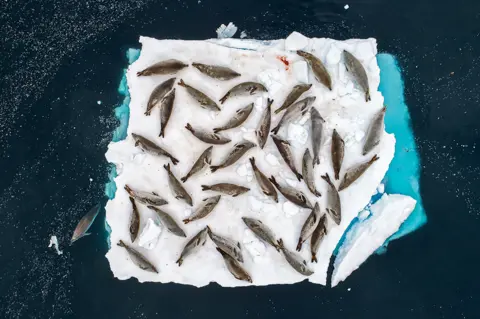 Cristobal Serrano / WPY
Cristobal Serrano / WPYAnimals In Their Environment category - Cristobal Serrano from Spain took this shot of crabeater seals resting on an ice floe off the Antarctic Peninsula. The seals have a close relationship with the sea-ice because it is the habitat that provides shelter and food (algae) for krill, tiny crustaceans. And it is the krill that are the main food source for the seals.

Mud-rolling mud-dauber by Georgina Steytler
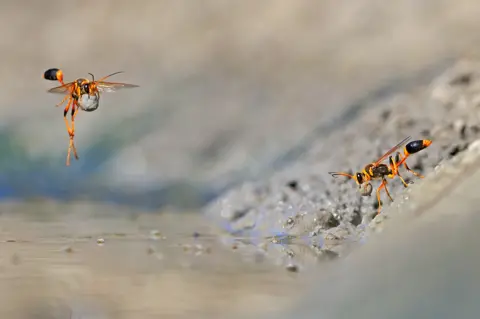 Georgina Steytler / WPY
Georgina Steytler / WPYBehaviour: Invertebrates category - Georgina Steytler took this picture of mud-dauber wasps in Walyormouring Nature Reserve in Western Australia by getting down to their level. In the mud. "I just got down in it with a long lens, taking shot after shot. I wanted to get one of the wasps carrying a mud ball, and to get two was incredible. It's luck but you have to be in the right place at the right time with the right equipment." The wasps use the balls to build nest chambers where they lay eggs on the paralysed bodies of spiders.

Night flight by Michael Patrick O'Neill
 Michael Patrick O'Neill / WPY
Michael Patrick O'Neill / WPYUnderwater category - This is a flying fish captured in the lens of American photographer Michael Patrick O'Neill. It was taken during a night dive off Florida's Palm Beach. These fish are very timid during the day but at night are easier to approach. Michael tried various camera and light settings to get this other worldly impression of the animal.

The sad clown by Joan de la Malla
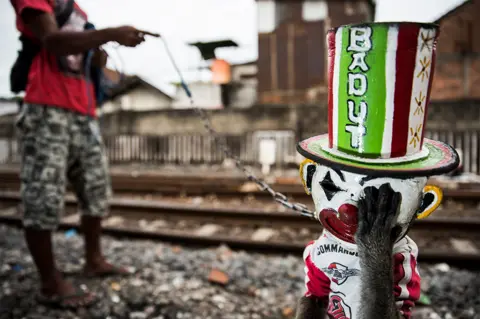 Joan de la Malla / WPY
Joan de la Malla / WPYWildlife Photojournalism category - This shocking image of a street monkey was taken by Joan de la Malla on the island of Java, Indonesia. It is a macaque that has been forced to wear a clown's mask. "It is painful and the macaque has its hand up to try to remove it," says Joan. The Spanish photographer has been working with animal welfare groups to try to get this type of street performance shut down. In the last couple of weeks, this has happened; and this particular animal, known as Timbul, is heading back to the wild.

Mother defender by Javier Aznar González de Rueda
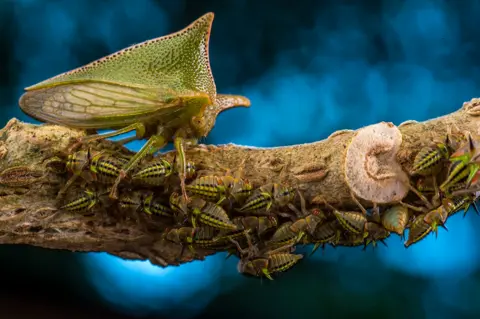 Javier Aznar González de Rueda / WPY
Javier Aznar González de Rueda / WPYWildlife Photographer Portfolio category - Javier Aznar González de Rueda, another Spanish photographer, entered a series of images, with this one featuring the Alchisme treehopper. The picture, taken in the El Jardín de los Sueños reserve in Ecuador, shows a mother guarding her nymphs. A treehopper will lay her eggs on the underside of a nightshade leaf and then cover them with a thin secretion. Once the eggs hatch, they develop through five nymphal stages, differing in size, colour and ornamentation.

Hellbent by David Herasimtschuk
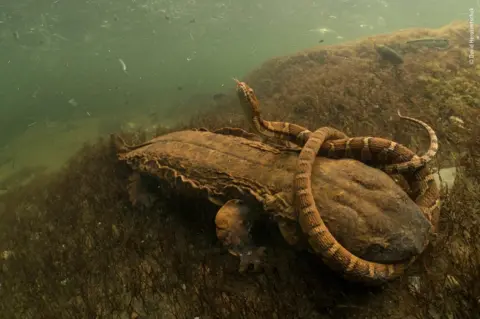 David Herasimtschuk / WPY
David Herasimtschuk / WPYBehaviour, Amphibians and Reptiles category - A Hellbender salamander holds a northern water snake in its jaws in this photo taken in Tennessee's Tellico River. David Herasimtschuk says the snake eventually managed to escape after wrestling with North America's largest aquatic salamander.

Windsweep by Orlando Fernandez Miranda
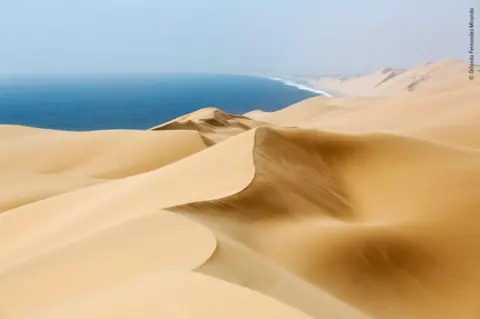 Orlando Fernandez Miranda / WPY
Orlando Fernandez Miranda / WPYEarth's Environments category - The top of a high dune on Namibia's desert Skeleton Coast, where mounds of wind-sculpted sand merge with crashing Atlantic waves. Look closer and you will see the fog that often forms in this region of Africa. As the fog drifts inland it delivers life-sustaining moisture to plants and insects.

WPY is one of the most prestigious competitions of its type in world photography.
Started in 1964, the competition is now organised by London's Natural History Museum.
An exhibition of the best images opens at the South Kensington institution on Friday. Next year's competition starts taking entries from Monday.
[email protected] and follow me on Twitter: @BBCAmos
